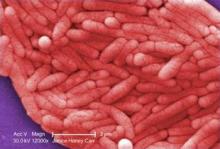Listeria and Salmonella infections in patients with rheumatoid arthritis decreased by 73% after they received updated advice about consuming foods likely to carry those pathogens.
The incidence of these infections dropped from 5/10,000 person-years to 1/10,000 after the 2006 educational campaign, Ms. Rebecca Davies reported.
"Although it may not be possible to eliminate this infection risk entirely, this ... shows the positive impact of informing patients of how to modify their risk of adverse events," wrote Ms. Davies, a research assistant at the University of Manchester, England, and her colleagues.
Because tumor necrosis factor is important in controlling intracellular bacterial infections, suppressing the protein can increase the risk of such infections. The British Society for Rheumatology’s Rheumatoid Arthritis Register tracks such events. In 2006, recognizing an early signal of increased infections by food-borne pathogens, the group advised patients taking the drugs to avoid high-risk foods, including raw eggs and raw poultry, unpasteurized milk, and some cheeses.
Ms. Davies and her colleagues reviewed the records of almost 12,000 patients enrolled in the registry – 9,376 of whom were taking anti-TNF-alpha drugs before 2006, and 2,347 of whom were taking them afterward. All were followed until death, last recorded visit, or through March 31, 2011. The review included data on all listeria and salmonella infections in the patients.
Nine patients who had ever taken one of the drugs experienced an infection before 2006 (four taking etanercept, three taking infliximab, and two taking adalimumab). Six patients experienced infections after 2006 (two etanercept, two infliximab, and two adalimumab). The crude incidence rates were 5/10,000 before 2006 and 1.4/10,000 afterward – a rate ratio of 0.27 and a 73% reduction.
The investigators found a similar result when they examined rates only in patients who were on therapy during the times in question. The incidence ratio was 4.6/10,000 before 2006, and 1.2 after 2006 – a rate ratio of 0.26 (74% reduction).
"This reduction was also found when allowing for a 90-day ‘lag window’ following treatment, accounting for any residual effect of the drug," the investigators noted.
The British Society for Rheumatology funded the study. The society receives funding from Abbott Laboratories, Merck, Pfizer, Roche, Swedish Orphan Biovitrum, and UCB. The society also contributes to rheumatology research at the University of Manchester. The paper did not note financial declarations from any of the individual authors.


